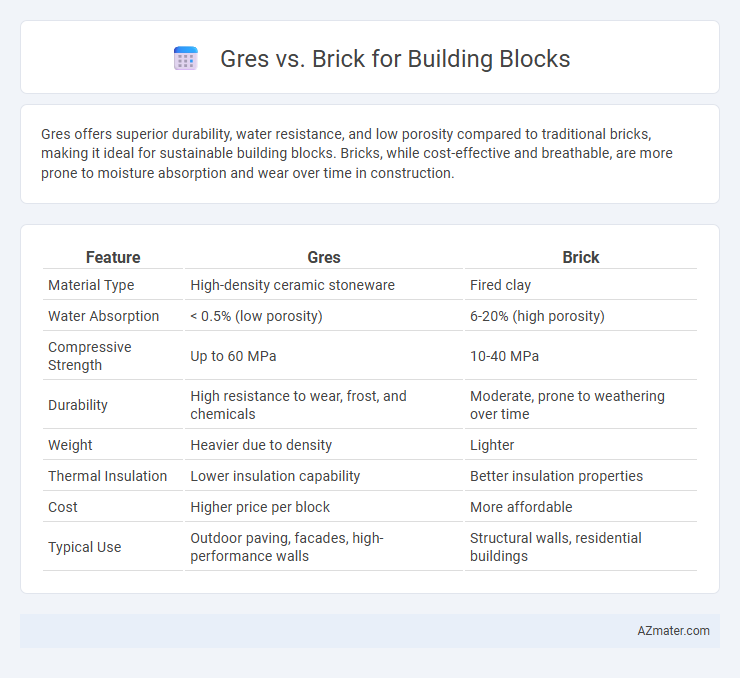Gres offers superior durability, water resistance, and low porosity compared to traditional bricks, making it ideal for sustainable building blocks. Bricks, while cost-effective and breathable, are more prone to moisture absorption and wear over time in construction.
Table of Comparison
| Feature | Gres | Brick |
|---|---|---|
| Material Type | High-density ceramic stoneware | Fired clay |
| Water Absorption | < 0.5% (low porosity) | 6-20% (high porosity) |
| Compressive Strength | Up to 60 MPa | 10-40 MPa |
| Durability | High resistance to wear, frost, and chemicals | Moderate, prone to weathering over time |
| Weight | Heavier due to density | Lighter |
| Thermal Insulation | Lower insulation capability | Better insulation properties |
| Cost | Higher price per block | More affordable |
| Typical Use | Outdoor paving, facades, high-performance walls | Structural walls, residential buildings |
Introduction to Gres and Brick as Building Blocks
Gres and brick are two popular materials for building blocks, each offering distinct characteristics and applications in construction. Gres, a type of vitrified ceramic tile, is known for its density, low porosity, and high durability, making it suitable for exterior cladding and flooring in both residential and commercial buildings. Bricks, traditionally made from clay and fired at high temperatures, provide excellent thermal insulation and structural strength, widely utilized in load-bearing walls and facades.
Key Material Properties of Gres
Gres, a dense and vitrified ceramic material, offers superior water resistance and low porosity compared to traditional brick, making it ideal for moisture-prone environments. Its high compressive strength and durability ensure long-lasting structural integrity, while enhanced thermal insulation properties contribute to energy efficiency in buildings. Unlike bricks, gres blocks exhibit excellent wear and frost resistance, reducing maintenance needs and extending lifespan.
Key Material Properties of Brick
Brick offers superior thermal insulation and fire resistance compared to gres, thanks to its porous clay composition and high firing temperatures. Its high compressive strength and durability make it suitable for load-bearing walls and long-lasting structures. The moisture absorption capacity of brick enhances its ability to regulate humidity, contributing to a healthier indoor environment in building applications.
Comparative Strength and Durability
Gres building blocks offer superior strength and enhanced durability compared to traditional bricks, making them suitable for high-load structural applications. Their dense, low-porosity composition provides increased resistance to weathering, reducing maintenance needs over time. Bricks, while still durable, are more prone to cracking and erosion under extreme environmental conditions.
Thermal and Acoustic Insulation Performance
Gres building blocks exhibit superior thermal insulation due to their dense composition, reducing heat transfer and enhancing energy efficiency in structures compared to traditional bricks. Acoustic insulation is also improved with gres blocks as their compact structure effectively dampens sound transmission, making them ideal for noise-sensitive environments. In contrast, bricks often have higher porosity, which can compromise both thermal retention and soundproofing abilities.
Cost Analysis: Gres vs Brick
Gres tiles typically have a higher initial cost compared to traditional bricks due to manufacturing processes and material composition. Bricks offer a more cost-effective option for large-scale construction projects, with lower material and labor expenses. Long-term durability and maintenance costs tend to balance out the initial price difference, making gres a viable choice despite its upfront premium.
Aesthetic and Design Flexibility
Gres tiles offer sleek, uniform surfaces with a modern aesthetic, providing design flexibility for minimalist and contemporary building blocks. Brick displays natural texture and warm tones that enhance traditional or rustic styles, allowing for varied patterns and custom finishes. Choosing between gres and brick depends on the desired architectural expression and adaptability in design schemes.
Environmental Impact and Sustainability
Gres building blocks, made from dense, natural clay and often fired at high temperatures, offer enhanced durability and lower porosity, resulting in longer lifespans and reduced need for replacement, which decreases overall environmental impact. Brick production typically involves higher energy consumption and emissions due to the traditional firing process, contributing to increased carbon footprints, whereas modern gres manufacturing techniques increasingly incorporate recycled materials and energy-efficient kilns. Sustainable building practices favor gres blocks for their recyclability, thermal insulation properties, and reduced resource depletion compared to conventional brick blocks.
Installation and Maintenance Considerations
Gres tiles offer a smoother, more uniform surface that simplifies installation compared to traditional bricks, reducing the need for extensive leveling and joint adjustments. Maintenance for gres involves minimal effort due to its non-porous nature, resisting stains and moisture that commonly affect brick surfaces. Brick requires regular sealing and occasional repairs to manage efflorescence and water damage, increasing long-term upkeep costs.
Conclusion: Choosing the Right Building Block
Gres offers superior durability, low water absorption, and excellent resistance to weathering, making it ideal for structures requiring high strength and longevity. Bricks provide better insulation, versatility in design, and cost-effectiveness, suitable for traditional and residential buildings. Selecting the right building block depends on the specific project requirements, climate conditions, and budget, ensuring optimal performance and aesthetic appeal.

Infographic: Gres vs Brick for Building Block
 azmater.com
azmater.com